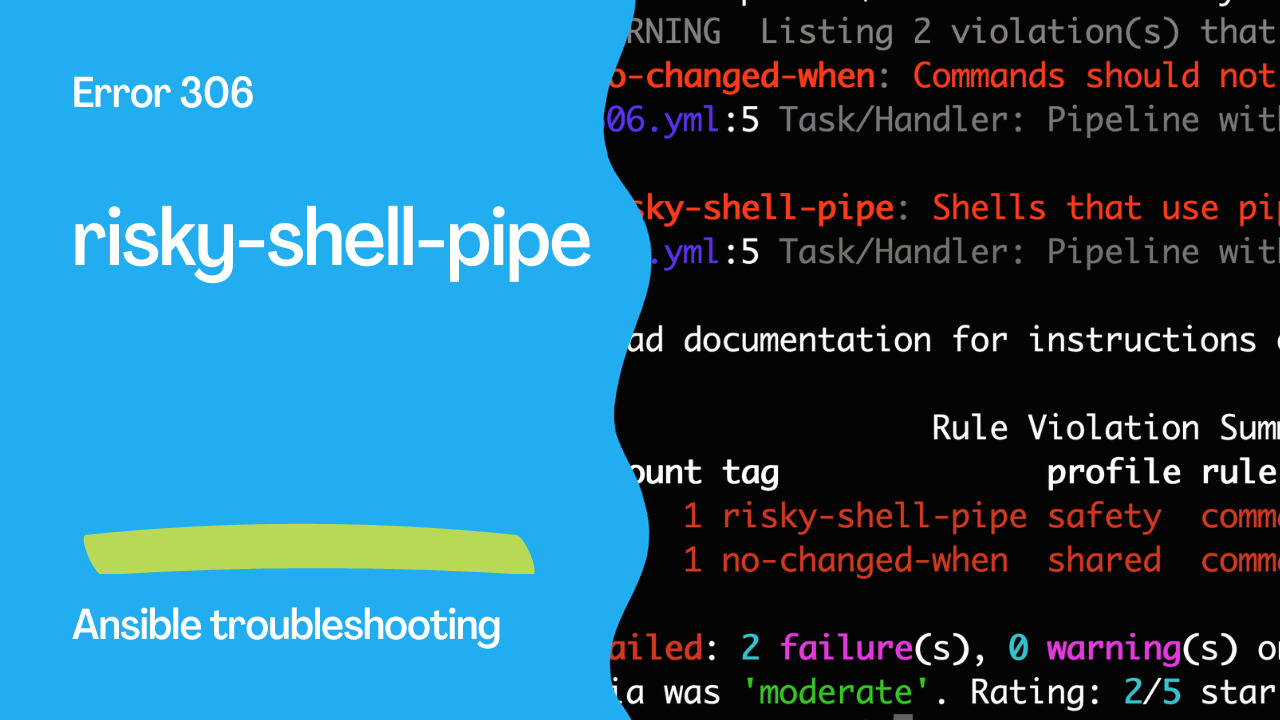Introduction
Ansible, the renowned automation tool, simplifies the management and configuration of IT infrastructure. While Ansible empowers users with a wide range of modules to streamline tasks, it’s vital to adhere to best practices for creating clean and predictable playbooks. Ansible-Lint, a popular linter for Ansible playbooks, enforces various rules to help you optimize your automation scripts. In this article, we delve into Rule 306, “risky-shell-pipe,” in Ansible-Lint which emphasizes the importance of using the bash pipefail option when employing the Ansible shell module to create pipelines. Setting pipefail ensures that tasks fail as expected if the first command in a pipeline fails.
Understanding Rule 306
Rule 306, “risky-shell-pipe,” is a valuable guideline for Ansible playbook authors. It promotes the use of the pipefail option when creating pipelines with the Ansible shell module. When using pipelines to pass output from one command to another, it’s crucial to set pipefail to ensure the reliability of task execution. The return status of a pipeline should reflect the exit status of the first command in the pipeline, ensuring that tasks fail if the initial command fails.
Problematic Code
Let’s explore a problematic code snippet that Rule 306 can identify in your playbooks:
---
- name: Example playbook
hosts: all
tasks:
- name: Pipeline without pipefail
ansible.builtin.shell: false | cat
In this code, the playbook creates a pipeline without setting the pipefail option. If the initial command (in this case, “false”) fails, the task may not fail as expected, leading to unpredictable behavior.
Output:
WARNING Listing 2 violation(s) that are fatal
no-changed-when: Commands should not change things if nothing needs doing.
306.yml:5 Task/Handler: Pipeline without pipefail
risky-shell-pipe: Shells that use pipes should set the pipefail option.
306.yml:5 Task/Handler: Pipeline without pipefail
Read documentation for instructions on how to ignore specific rule violations.
Rule Violation Summary
count tag profile rule associated tags
1 risky-shell-pipe safety command-shell
1 no-changed-when shared command-shell, idempotency
Failed: 2 failure(s), 0 warning(s) on 1 files. Last profile that met the validation criteria was 'moderate'. Rating: 2/5 star

Correct Code
The corrected code that adheres to Rule 306 is as follows:
---
- name: Example playbook
hosts: all
become: false
tasks:
- name: Pipeline with pipefail
ansible.builtin.shell:
cmd: set -o pipefail && false | cat
executable: /bin/bash
- name: Pipeline with pipefail, multi-line
ansible.builtin.shell:
cmd: |
set -o pipefail # <-- adding this will prevent surprises
false | cat
executable: /bin/bash
In the improved version, the playbook sets the pipefail option explicitly using the set -o pipefail command. This ensures that if the initial command ("false") in the pipeline fails, the task fails as expected, providing more predictable behavior.
Why Use the pipefail Option
Using the pipefail option is crucial for several reasons:
Predictable Failure: The pipefail option ensures that if the first command in a pipeline fails, the task also fails. This behavior is essential for predictable and reliable playbook execution.
Idempotence: The pipefail option aligns with Ansible’s idempotent nature, enhancing playbook reliability and consistency.
Enhanced Debugging: With pipefail, it’s easier to diagnose issues in the pipeline by clearly identifying the source of failure.
Security: Setting pipefail reduces the potential for unintended consequences due to failed pipeline commands.
Exception Handling
While Rule 306 encourages the use of the pipefail option, there may be situations where you genuinely don’t need this behavior, such as when executing non-critical tasks. In such cases, you can continue without setting pipefail, but it’s important to weigh the trade-offs between reliability and flexibility carefully.
Conclusion
Rule 306, “risky-shell-pipe,” is a valuable guideline within Ansible-Lint that promotes reliability and predictability in Ansible playbooks. By using the pipefail option when creating pipelines with the Ansible shell module, you ensure that tasks fail as expected when the first command in the pipeline fails. This practice enhances the predictability and reliability of your automation tasks, making your playbooks more robust and easier to troubleshoot. Ultimately, adhering to this rule contributes to a more efficient and secure Ansible workflow, ensuring that your playbooks perform optimally and effectively manage your IT infrastructure.
Academy
Learn the Ansible automation technology with some real-life examples in my
Udemy 300+ Lessons Video Course.

My book Ansible By Examples: 200+ Automation Examples For Linux and Windows System Administrator and DevOps

Donate
Want to keep this project going? Please donate
